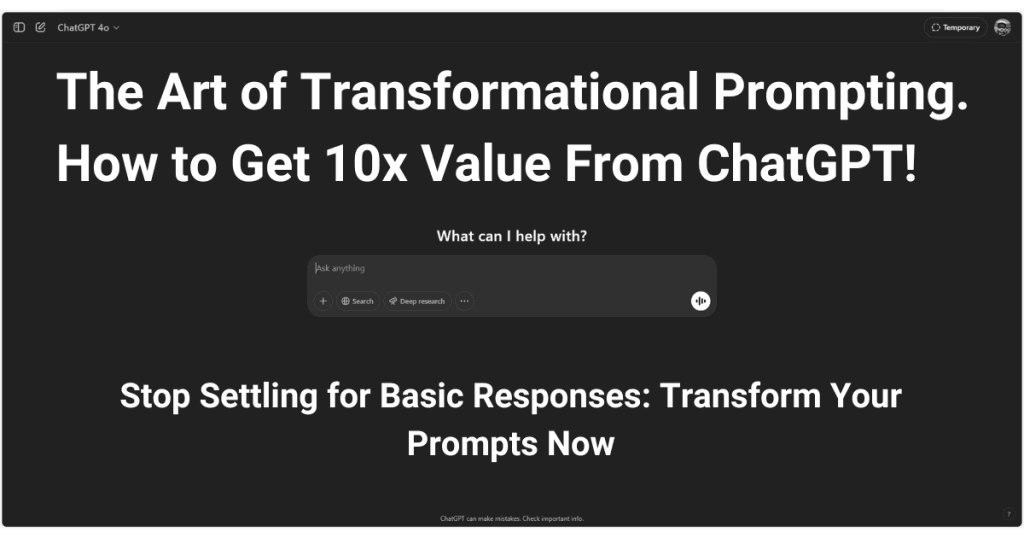
In today’s AI-powered world, the difference between mediocre and exceptional results from tools like ChatGPT isn’t about technical expertise—it’s about how you communicate with the AI. This guide will walk you through the step-by-step process of transforming basic prompts into powerful instructions that deliver precisely what you need.
Why Most People Get Mediocre Results
The majority of ChatGPT users take a “query” approach—they ask simple, vague questions expecting the AI to read their minds. This results in generic, surface-level responses that require multiple follow-ups and refinements.
Consider this common scenario: You ask ChatGPT for “tips on public speaking,” and receive a generic list of advice you could find anywhere. You then spend the next 5-6 messages trying to narrow down what you actually wanted.
New to ChatGPT? Start with our Complete Beginner's Guide to ChatGPT before diving into these advanced techniques.
The Transformation Framework
Transforming your prompts means shifting from asking questions to providing context and direction. Here’s a framework that consistently delivers superior results:
1. Define Your Audience
Tell ChatGPT exactly who will be consuming the information. Include:
- Demographics (age, profession, income level)
- Experience level with the subject
- Specific challenges they face
- Their current knowledge baseline
2. Specify the Format and Scope
Be explicit about:
- The content format (article, bullet points, comparison table)
- Length requirements (word count, time to read)
- Level of detail (overview vs. comprehensive analysis)
- Tone and writing style (formal, conversational, technical)
3. Provide Contextual Constraints
Set boundaries to focus the AI:
- What to include and exclude
- Assumptions to make or avoid
- Perspective or angle to take
- Time or resource limitations to consider
4. Request Specific Outputs
Clearly state what deliverables you expect:
- Number of items/examples
- Structure of the response
- Supporting elements (rationale, sources, examples)
- Follow-up questions you want addressed
Transformation in Action: Real-World Examples
Career Development
Basic Prompt (What Most People Do):
“How to ask for a promotion?”
Result: A generic list of common advice like “schedule a meeting,” “highlight your achievements,” and “be confident.”
Transformed Prompt (The 10x Approach):
“I’m a mid-level software developer (4 years experience) at a 500-person tech company. I’ve consistently exceeded expectations for the past 18 months and taken on senior-level responsibilities, but haven’t received a title change or significant compensation increase. My manager is generally supportive but extremely busy and metrics-focused. Draft a detailed promotion request strategy for my upcoming quarterly review that includes: 1) A script for initiating the conversation, 2) Three specific accomplishments to highlight with quantifiable impact, 3) Market research points about compensation for similar roles, and 4) A fallback plan if immediate promotion isn’t possible.”
Result: A personalized, actionable strategy tailored to the specific workplace dynamics, with ready-to-use talking points and contingency planning.
Content Creation
Basic Prompt (What Most People Do):
“Ideas for YouTube videos about cooking.”
Result: A list of generic cooking video concepts like “How to Make Pasta,” “Quick Breakfast Ideas,” or “Baking Basics.”
Transformed Prompt (The 10x Approach):
“I’m launching a YouTube cooking channel targeting busy parents who want to create healthy weeknight meals in under 30 minutes. My kitchen skills are intermediate, and I want to focus on Mediterranean and Asian-inspired dishes using accessible ingredients from standard grocery stores. Suggest 7 video concepts that would perform well with this audience, including: 1) An attention-grabbing title, 2) The main nutritional benefit to highlight, 3) A unique twist to differentiate from similar content, and 4) One challenging technique I should master to add credibility.”
Result: Highly targeted video concepts aligned with a specific audience, content strategy, and skill level, plus additional elements to enhance viewer engagement and channel growth.
Common Mistakes to Avoid
- Overconstraining: Providing so many requirements that you limit creative solutions
- Underspecifying: Failing to communicate critical context or requirements
- Misaligning expectations: Asking for expert-level content in fields requiring specialized knowledge
- Neglecting iteration: Treating the first response as final rather than a starting point
Advanced Techniques for Power Users
Once you’ve mastered the transformation framework, you can enhance your results further with these techniques:
Role Assignment
Begin prompts with “As a [specific expert role],” to frame the AI’s perspective.
Chain-of-Thought Guidance
Ask the AI to “think step by step” or “reason through this problem” before providing its final answer.
Comparative Analysis
Request the AI to explore multiple approaches and compare their strengths and weaknesses before recommending the best option.
Creative Constraints
Intentionally add unusual limitations that force creative thinking (e.g., “Explain this concept using only analogies from nature”).
Measuring Your Success
You’ll know your prompt transformation is working when:
- The first response requires minimal or no revisions
- You receive unique insights beyond common knowledge
- The AI generates content that feels personalized to your specific situation
- You spend less time going back and forth with follow-up questions
Start Your Transformation Journey
The best way to improve your prompting skills is through deliberate practice. Take one basic prompt you’ve used before and apply the transformation framework. Compare the results and continue refining your approach.
With these strategies, you’ll move from being a passive consumer of AI-generated content to a skilled director, guiding ChatGPT to deliver exactly what you need—saving time, reducing frustration, and unlocking the true potential of this powerful technology.
